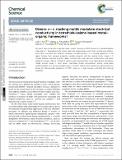| dc.contributor.author | Xie, Lilia S. | |
| dc.contributor.author | Alexandrov, Eugeny V. | |
| dc.contributor.author | Skorupskii, Grigorii | |
| dc.contributor.author | Proserpio, Davide M. | |
| dc.contributor.author | Dinca, Mircea | |
| dc.date.accessioned | 2020-07-17T19:05:36Z | |
| dc.date.available | 2020-07-17T19:05:36Z | |
| dc.date.issued | 2019-07 | |
| dc.date.submitted | 2019-06 | |
| dc.identifier.issn | 2041-6539 | |
| dc.identifier.uri | https://hdl.handle.net/1721.1/126243 | |
| dc.description.abstract | We report three electrically conductive metal-organic frameworks (MOFs) based on a tetrathiafulvalene linker and La3+. Depending on the solvent ratios and temperatures used in their solvothermal synthesis, these MOFs crystallize with different topologies containing distinct π-π stacking sequences of the ligand. Notably, their transport properties correlate rationally with the stacking motifs: longer S⋯S contact distances between adjacent ligands coincide with lower electrical conductivities and higher activation energies. Diffuse reflectance spectroscopic measurements reveal ligand-based intervalence charge transfer bands in each phase, implicating charge delocalization among mixed-valent tetrathiafulvalene units as the dominant mode of transport. Overall, these frameworks demonstrate how tuning the intermolecular interactions in MOFs serves as a route towards controlling their physical properties. | en_US |
| dc.description.sponsorship | U.S. Department of Energy, Office of Basic Energy Sciences (Grant DE-SC0018235) | en_US |
| dc.description.sponsorship | National Science Foundation Graduate Research Fellowship Program (Grant 1122374) | en_US |
| dc.language.iso | en | |
| dc.publisher | Royal Society of Chemistry (RSC) | en_US |
| dc.relation.isversionof | 10.1039/C9SC03348C | en_US |
| dc.rights | Creative Commons Attribution Noncommercial 3.0 unported license | en_US |
| dc.rights.uri | https://creativecommons.org/licenses/by-nc/3.0/ | en_US |
| dc.source | Royal Society of Chemistry (RSC) | en_US |
| dc.title | Diverse π–π stacking motifs modulate electrical conductivity in tetrathiafulvalene-based metal–organic frameworks | en_US |
| dc.type | Article | en_US |
| dc.identifier.citation | Xie, Lilia S. et al. "Diverse π–π stacking motifs modulate electrical conductivity in tetrathiafulvalene-based metal–organic frameworks." Chemical Science 37, 10 (July 2019): 8558-65 doi 10.1039/C9SC03348C ©2019 Author(s) | en_US |
| dc.contributor.department | Massachusetts Institute of Technology. Department of Chemistry | en_US |
| dc.relation.journal | Chemical Science | en_US |
| dc.eprint.version | Final published version | en_US |
| dc.type.uri | http://purl.org/eprint/type/JournalArticle | en_US |
| eprint.status | http://purl.org/eprint/status/PeerReviewed | en_US |
| dc.date.updated | 2019-12-17T14:51:36Z | |
| dspace.date.submission | 2019-12-17T14:51:39Z | |
| mit.journal.volume | 37 | en_US |
| mit.journal.issue | 10 | en_US |
| mit.metadata.status | Complete | |
